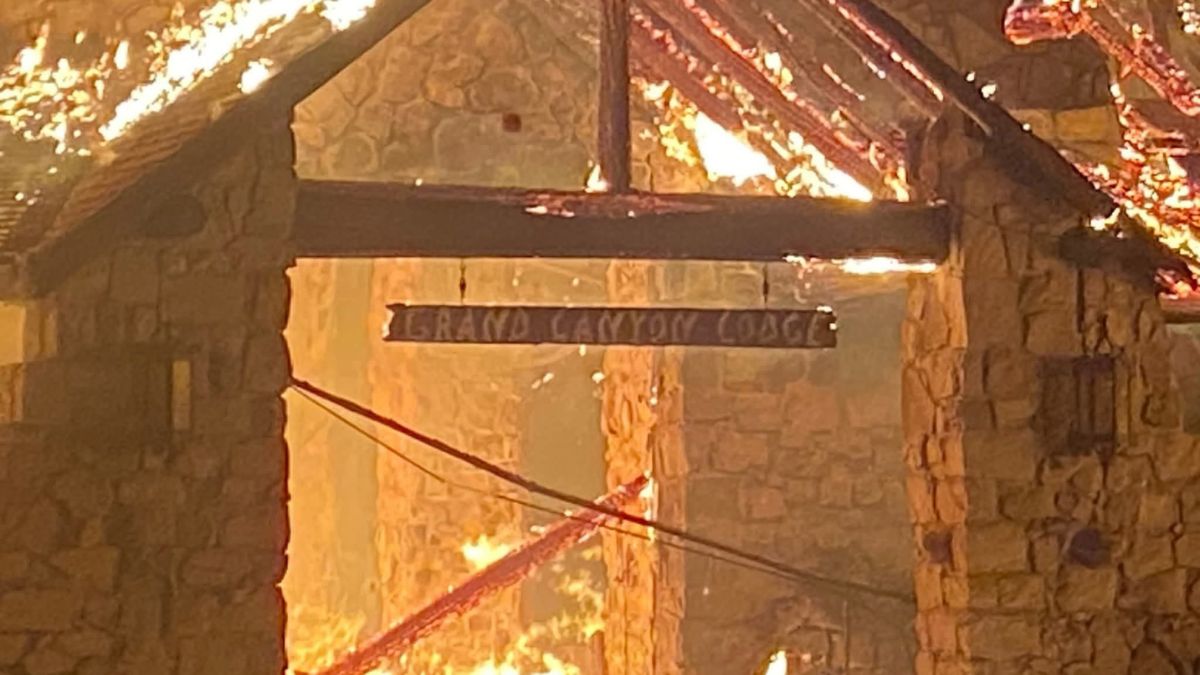Arizona: A rapidly expanding wildfire sparked by lightning on July 4 has destroyed the historic Grand Canyon Lodge at the North Rim of Grand Canyon National Park, forcing thousands of visitors and staff to evacuate and prompting a full seasonal closure of the North Rim, officials confirmed Monday.
The Dragon Bravo Fire, which had initially been monitored under a “confine and contain” strategy by the National Park Service (NPS), exploded in size over the weekend due to extreme wind conditions, record heat, and low humidity. By Monday morning, the fire had grown to 3,471 acres, burning through the North Rim’s developed area and consuming between 50 and 80 structures, including cabins, the visitor center, a wastewater treatment facility, and staff housing.
“The Dragon Bravo Fire on the North Rim of Grand Canyon National Park exhibited extreme and volatile fire behavior the evening of July 12, resulting in a 500-acre expansion,” the NPS said in an official update. “Fire managers have confirmed the loss of the Grand Canyon Lodge and numerous historic cabins in the developed area.”
The North Rim Grand Canyon Lodge was lost in a forest fire, along with other park amenities.
It doesn’t have to be this way.
This is due to decades of overgrowth, caused by the prohibition of logging in the parks due to environmentalists and the Democrats who enable them. pic.twitter.com/gp4IISgblc
— Jeremiah Cota ✝️🇺🇸 (@jeremiahcota) July 13, 2025
Also Read: Fall River Assisted Living Fire: 9 Killed at Gabriel House in Massachusetts
What Sparked the Grand Canyon Lodge Fire?
The Dragon Bravo Fire was ignited by lightning on July 4 and remained active in remote areas of Kaibab National Forest near Jacob Lake. But conditions escalated on the night of July 12 at approximately 10:30 p.m., when sustained winds of 20 mph and gusts up to 40 mph caused the fire to escape its containment lines.
Firefighters responded aggressively overnight, conducting aerial bucket drops near the Grand Canyon Lodge and Transept Canyon. However, retardant drops were not immediately feasible due to a chlorine gas leak at the park’s water treatment facility, which forced firefighting personnel to evacuate key zones.
Despite the hazardous conditions, no injuries or fatalities have been reported. All staff, guests, and nearby campers were evacuated in time.
News Release—Grand Canyon National Park Update on Dragon Bravo Firehttps://t.co/uZyFtMULkl pic.twitter.com/Vl2QHWf2Uh
— Grand Canyon NPS (@GrandCanyonNPS) July 13, 2025
The Grand Canyon Lodge has burned down due to the Dragon Bravo Fire in the Park. Other structures have been impacted as well.
On today’s show I talk about the multiple managed fires that blew out yesterday due to weather events that rolled over the fire areas. Thanks to the… pic.twitter.com/OVG5MUgfZB
— The Hotshot Wake Up (@HotshotWake) July 13, 2025
North Rim Lodge and Visitor Facilities Lost to Flames
The Grand Canyon Lodge, a National Historic Landmark dating back to the 1930s, was the only in-park lodging on the North Rim. Built with massive ponderosa beams and limestone, the lodge was a favorite of photographers and park guests for nearly a century.
“As stewards of some of our country’s most beloved national treasures, we are devastated by the loss of the Grand Canyon Lodge,” said Debbie Albert, spokesperson for Aramark, the company that operated the lodge. “We are grateful that all of our employees and guests have been safely evacuated.”
Also lost in the fire were the North Rim Visitor Center, administrative offices, a gas station, employee housing, and infrastructure critical to the park’s daily operation.
What’s Closed at the Grand Canyon?
With fire activity still very active and suppression efforts ongoing, the North Rim will remain closed for the rest of the 2025 season, the National Park Service announced.
Closures also extend to all interior canyon trails and associated facilities. These include:
- North Kaibab Trail
- South Kaibab Trail
- Phantom Ranch
- Bright Angel Trail below Havasupai Gardens
- All inner corridor campgrounds
“We’re focused on protecting lives, containing the fire, and keeping responders safe,” said Ed Keable, superintendent of Grand Canyon National Park.
Governor Demands Federal Review
Arizona Governor Katie Hobbs issued a statement late Sunday calling for a federal investigation into how the fire was managed in its early stages.
“They must first take aggressive action to end the wildfire and prevent further damage,” she posted on X. “But Arizonans deserve answers for how this fire was allowed to decimate the Grand Canyon National Park.”
I am incredibly saddened by the destruction of the historic Grand Canyon Lodge, and my heart goes out to every person impacted by the Dragon Bravo Fire near the Grand Canyon’s North Rim.
Thank you to every firefighter and first responder taking action to combat the flames.
— Governor Katie Hobbs (@GovernorHobbs) July 14, 2025
Firefighters Shift to Full Suppression Strategy
By July 13, the NPS had shifted to an aggressive full suppression strategy to slow further spread, especially toward the Roaring Springs drainage and remaining infrastructure. Retardant drops resumed on the eastern side of the fire zone.
Fire behavior remains highly active due to hot temperatures, low humidity, and strong wind gusts. The secondary White Sage Fire, also sparked by lightning, has consumed over 45,000 acres in Kaibab National Forest, adding pressure to emergency resources.
“The primary objectives of current fire operations remain: protecting the lives and safety of firefighting personnel and the public, preserving the remaining structures on the North Rim, and safeguarding cultural and natural resources within Grand Canyon National Park,” the NPS said.







